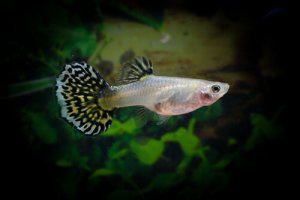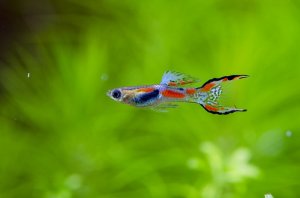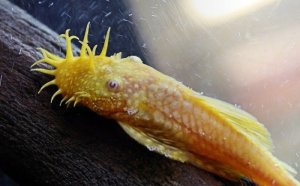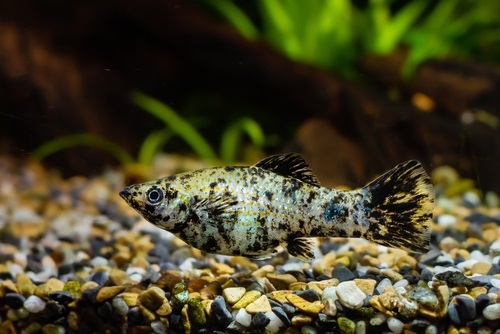
The Dalmatian Molly is a variation of the common Molly fish Poecilia Sphenops, a livebearing fish that is related to guppies, swordtails, and platies. The Molly fish lives entirely in the new world (north and south America) In fact, it is found around the coast of the Gulf of Mexico and Caribbean sea, namely off the southern United States and some areas of Mexico. Read on to find out how to care for the Dalmatian Molly – a striking black and white variety of this little fish that is full of character.
Breed Overview
| Origin | Southern US, Mexico |
| Lifespan | 3-5 years |
| Size | 1.5 -5” (4-13 cm) |
| Colors | White with black speckled patches |
| Food | Omnivorous |
| Tank Size | Min 30 gallons (114 liters) for a shoal of 5-6 fish |
| Temperament | Curious and individual |
| Water Temperature | 72-78 F (22-26 C) |
| Water pH | 7.5-8.5 |
| Ammonia, Nitrates, And Nitrites | 0 |
Appearance
At first glance, the Dalmatian Molly is pale white or silver in color with black flecks all over its body. This striking color makes it very popular. However, did you know that it is actually the same species as other breeds like the black Molly? All of them have been bred from the fish Poecilia sphenops.
How can you tell if a Molly fish is male or female?
Molly fish do not exhibit sexual dimorphism like some other species. However, it’s still possible to sex them if you know what you’re looking for:
- Female mollies grow larger
- Males have a specialized anal fin, or gonopodium
- Male Mollies tend to have longer fins
- Males have slightly brighter colors
Author’s Note: You may confuse the Dalmatian Molly with the sailfin Molly, as both have black and white speckled patterns. However, they are two different species. The sailfin Molly has a large dorsal fin that gives it it’s name. In addition, its patterning is a lot more regular. Some may find the Dalmatian Molly looks like it has been splashed with black and white paint!
Tank Setup And Maintenance
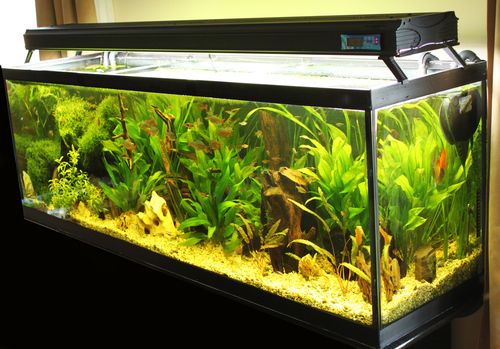
What Size Tank Do Dalmatian Molly Fish Need?
A general rule of keeping Molly fish is to use a tank of minimum 30 gallons (114 liters) this is because Mollies need about 5-10 gallons per individual fish. However, they also need to be kept in groups.
It’s definitely not an option to keep a Dalmatian Molly alone. These are shoaling fish and they require a group to feel safe. Therefore, a big enough tank is a must.
Plants, Filtration, And Substrate
Dalmatian Molly fish are very hardy and live in many habitats in the wild. In fact, they are known for their ability to adapt to both freshwater aquariums and brackish water. However, there are many things you can do to improve the water quality in your tank.
Filtration
Either a canister or hang-on-back filter can work with a Molly tank, as can a sponge filter. The biggest consideration is tank size. Like with guppies, a canister filter can be better for a tank over 30 gallons (114 liters). Otherwise, a gentler sponge or HOB filter will ensure the current is not too strong for them.
Substrate
Molly fish do well with either a sandy or gravel substrate. However, f you have bottom dwellers like cory catfish, it’s best to use sand as this is gentler on their stomachs. Otherwise, you can opt for colorful gravel if you wish.
Plants:
It’s always good to add plants to your Molly fish tank. Some good examples include:
- Guppy grass
- Amazon sword
- Water milfoil
- Cabomba or hornwort
- Marimo moss balls
- Java fern
- Java moss
- Amazonian pennywort
Tankmates
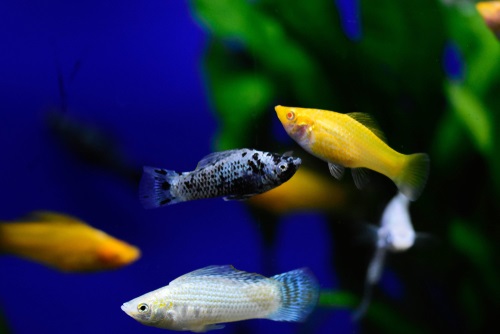
Molly fish get on well with a variety of tankmates and the Dalmatian Molly is no exception. Generally, they get on well with other livebearing fish such as guppies, Endlers’ livebearers, platies, and swordtails, plus smaller fish like danios.
They can also cohabit with bottom-dwelling fish like cory catfish and kuhli loaches. However, you may be surprised at the variety of tankmates these Mollies can get on with. For example, they can actually cohabit with betta fish, so long as you set your tank up correctly. In this instance, you should add an additional 10 gallons (38 liters) of horizontal space to provide enough territory so that disputes do not occur.
Likewise, Mollies can also be kept with gouramis, which are a popular recommendation for many beginners.
Author’s Note: With any tankmates, the requirements for each species should still be observed. Therefore, you will have to adjust your tank size and setup accordingly. For example, to keep your Dalmatian Molly fish with gouramis, you will still have to provide a shoal of 4 or more gouramis. This is because gouramis, like Mollies, need to be kept in groups. Thus, you may find yourself keeping over 8 fish in a tank, requiring up to 50 or 60 gallons to ensure there is enough territory for all of them.
Feeding Your Dalmatian Molly
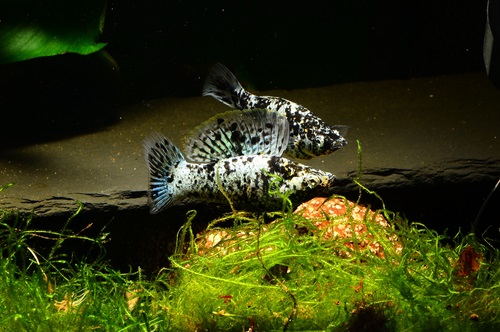
Feeding Molly fish is relatively simple, as these guys don’t need anything that different from any other livebearer. Choose a flake food that is formulated for tropical fish and enrich their diet with either fresh (live) or frozen protein like daphnia, brine shrimps, and bloodworms.
However, only ever feed fish what they can eat in 5 minutes. Mollies are active fish with a relatively fast metabolism. Sometimes it can help to feed little and often (twice per day) as opposed to once.
Generally, you will be able to see whether they are still hungry, as hungry fish will swim to the surface of the water.
Behavior And Temperament
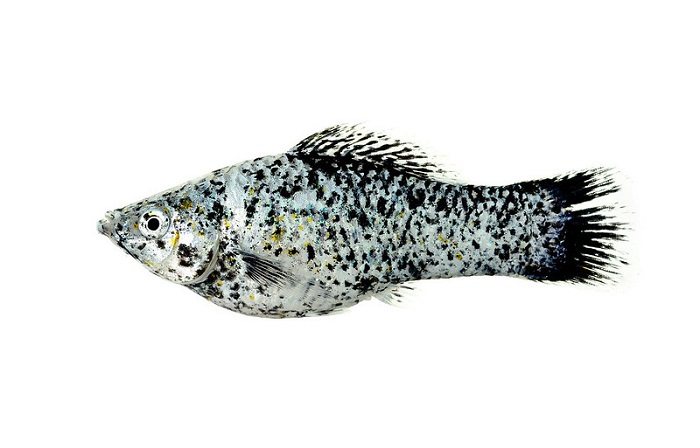
Ultimately, the behavior and temperament of Molly fish are relatively similar to other livebearer fish in the Poeciliidae family. However, there are some notable and important differences.
Firstly, Mollies tend to be noticeably more peaceful than guppies. However, another common observation among aquarists is that Molly fish tend to have very individual personalities. Distinct group dynamics to develop in a shoal of Mollies, and thus it’s important to keep them in groups, as they need these relationships.
Schooling vs Shoaling Behavior
One key point is that Molly fish are shoaling fish. Shoaling means they will generally cohabit closely with each other. However, schooling refers to swimming in unison. This is a common behavior in fish such as tetras and danios, but you won’t observe it in the Molly.
Why Do My Molly Fish Keep Chasing Each Other?
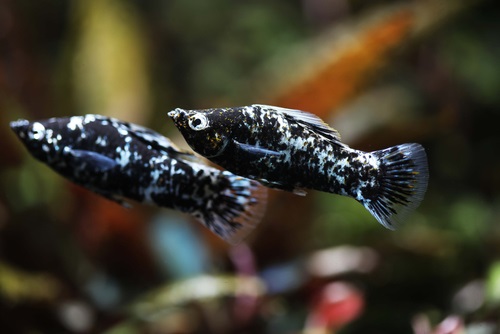
Due to the peaceful nature of the Molly fish, it can be alarming when you see them chase each other. However, there are often common causes for this behavior:
- Male Fish Chasing Females
One common reason your Molly fish are chasing each other is that the males are trying to impregnate the female. This can happen amongst Dalmatian Mollies, or it can happen across different breeds of Molly. Either way, these livebearers tend to breed at a relatively rapid rate.
Author’s Note: A good way to prevent your male Molly fish from chasing, harassing, or impregnating your females, is to keep an uneven ratio of male to female fish. A good idea is to keep three females for every male. That way, no one female gets chased too much. You can also minimize this chasing behavior by increasing tank size.
- Territorial Disputes
Another reason Molly fish may chase each other is due to disputes over territory. This can be between female Mollies, males, and females, or just males. That being said, it is marginally a bit more common amongst males. Either way, ensure your tank is large enough to avoid this.
Pests And Diseases
Molly fish are subject to many of the same pests and diseases as other aquarium fish. This section will outline what these look like and how to investigate further, but also focuses on color change, as this can be significant in the distinctly patterned Dalmatian Molly.
Bacterial Infections
Bacterial infections include swim bladder disease, dropsy, and fin rot. These range from moderate to severe, but apart from dropsy, you can generally treat them by isolating the fish in a separate tank and using a course of over-the-counter medication.
Fungal And Parasitic Infections
Fungal and parasitic infections are similar to bacterial ones in that you can treat them with medication and by isolating the fish. A good indicator of these tends to be color change, for example, ich looks like white spots on your fish’s body. Likewise, velvet disease or ‘gold dust’ looks like a smattering of gold flecks.
Why Is My Dalmatian Molly Changing Color?
Color change can be a problem in many kinds of aquarium fish. However, it is especially important to keep an eye out for the Dalmatian Molly. Why is this? Simply put, the natural patterning of these fish can look relatively similar to toxic ammonia overload symptoms.
However, note that ammonia burns will be in large patches. On the other hand, the natural black flecks of your Dalmatian Molly are much smaller.
Another color change you may see is your fish turning black all over. This tends to happen overall, as opposed to in patches. This form of color change can happen simply as part of the natural aging process!
Breeding Dalmatian Mollies
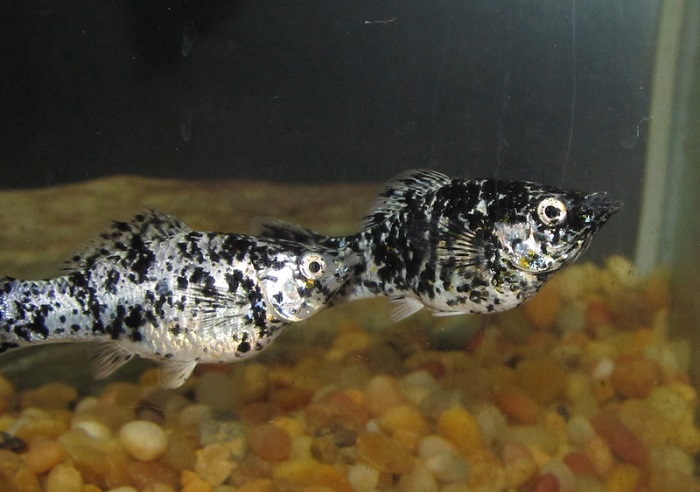
As a general rule, the breeding process for the Dalmatian Molly is similar to other Mollies and other livebearers like guppies. In fact, if you know how guppies mate, it is very easy to breed Mollies. The process of setting up a breeding tank and removing the male once you know the female is pregnant is the same.
How To Do Dalmatian Mollies Mate?
Like other livebearing fish, the mating process for Dalmatian Mollies is complex. For example, the size of females tends to affect male mate choice, as it indicates fertility. The mating process is also complex as it really depends on whether your Molly fish are in the mood to mate.
What Factors Affect Molly Fish Mating?
The good news is Mollies are some of the easiest fish to breed. However, there are a few things that are important to understand as part of the mating process outlined below:
1. Female Receptivity
Often you see male Mollies chasing females, but in fact, for mating to go off without a hitch, the female fish has to be receptive like fin waggling. This generally means she will show behavior and body language that allows him to impregnate her.
2. Temperature
Did you know that a slightly hotter temperature is ideal for the Molly fish to mate? Regardless of the temperature you keep your fish at, the optimum temperature for breeding is 78-82 F (26-28 C).
3. Tank Conditions
Remember that all the usual considerations for water quality are just as important during the breeding period as at other times. Male fish may show little interest in mating if nitrate levels are too high.
Dalmatian Molly Gestation Period
Aquarium fish in the family Poeciliidae share a few common characteristics with regard to reproduction. These include Mollies, guppies, swordtails, and platies. One of the most distinctive of these is that the female can store sperm inside her body and self-fertilise her eggs with them at will.
As a result, the Dalmatian Molly gestation period can vary rapidly. In general, Mollies gestate (are pregnant) for 40-60 days. However, there are reports of the Dalmatian Molly gestating for up to 70 days.
How Do I Know When My Molly Fish Is About To Give Birth?
One of the biggest signs of late-stage pregnancy in any Molly fish is the darkening of the gravid spot, a triangular area near the anal fin. When your Molly is nearing birth, this will be dark brown to almost black and immediately before labor your Molyl may hide and appear restless.
During the actual birthing process, you will observe contractions as the female Molly passes fry out of her body.
- Caring For Fry: You may have heard that Molly fish are less prone to eating their young than guppies and some other livebearers. This is true, but you should still take a precaution and separate the fry from the adult, who can go back to your main tank. Fry can be fed on baby brine shrimp or crushed specialized fry food. They generally tend to be quite big and hardy.
- How Do I Ensure The Fry Have The Dalmatian Pattern? Fish genetics is complex, especially with regard to coloration. As a result, it’s impossible to predict exactly what genetics fish fry will have. However, the best chance of continuing the Dalmatian strain is simply to cross two Dalmatian Molly fish.
Final Thoughts
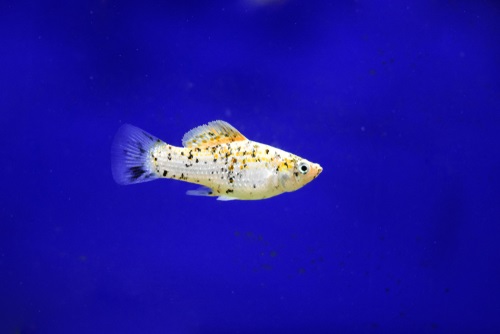
There’s a reason why Molly fish are so popular, and that’s because of their unique temperaments, ease of care, and also the fact they are one of the easiest fish for first-time aquarists to breed. In short, there are many great reasons to opt for a tank of Dalmatian Mollies, and hopefully this guide with give you a strong introduction to how to look after these mesmerizing, fascinating livebearers.


